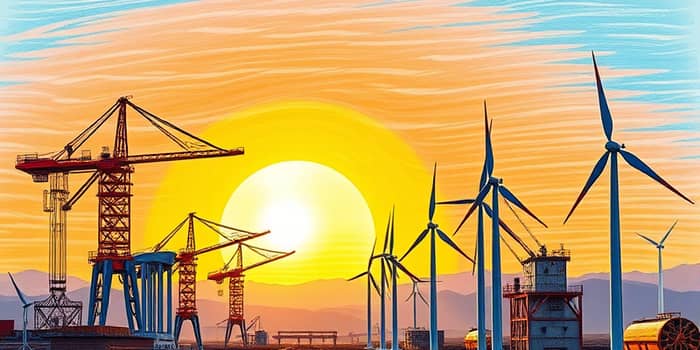As the world grapples with evolving economic forces, understanding the anatomy of multi-decade periods when commodities soar becomes critical. Commodity supercycles shape national destinies, fuel inflation waves, and rewrite investment rules for decades.
Understanding Commodity Supercycles
A commodity supercycle is not a fleeting price spike. It represents sustained demand significantly outpacing supply over a prolonged horizon. Unlike typical five-year cycles, supercycles can span over a decade, driven by systemic transformations in consumption and production.
During such phases, commodities—from energy and metals to agriculture—trade well above their long-term trends. These surges reflect broad-based structural shifts in global markets rather than transient shocks, altering economic trajectories across continents.
Typical Cycles vs. Supercycles
Standard commodity cycles progress through four phases: contraction, recovery, expansion, and overheating. They average around five years from peak to peak. In contrast, supercycles extend the expansion phase for ten years or more, as supply fails to catch up with exploding demand.
While cycles correct themselves through investment bursts and price collapses, supercycles persist due to persistent supply constraints and regulatory hurdles. Mining and drilling projects often require long lead times, reinforcing price rallies.
Lessons from History
History offers three landmark supercycles:
- 1970s: Oil shocks and global industrial growth reshaped energy markets.
- 1999–2008: China’s infrastructure boom drove metals and energy prices skyward.
- 2003–2011: Rapid urbanization in China and India fueled cement, steel, and copper demand.
Quantitatively, Australia’s iron ore exports to China surged from near zero in 2000 to over $60 billion annually by 2011. Chile’s copper shipments climbed from $1 billion to $20 billion in the same period. These examples underscore how concentrated demand can lift entire regional economies.
Key Drivers of Supercycles
Multiple forces converge to create commodity supercycles:
- Rapid industrialization and urbanization in emerging economies spurs massive resource consumption.
- Green energy transition and electrification surge elevates demand for copper, lithium, nickel, and rare earths.
- Monetary policy easing and currency weakness make commodities attractive inflation hedges.
- Persistent underinvestment in exploration keeps supply growth muted.
Together, these factors forge an environment where prices can remain elevated for years, often stoking secondary investment booms and speculative flows through futures markets.
Macroeconomic and Geopolitical Impacts
For commodity exporters, supercycles herald a period of abundant revenues and easier borrowing conditions. Governments ramp up spending on social programs, infrastructure, and debt reduction when prices peak.
Conversely, a downturn can unleash debt stress. Nations that neglected diversification feel the sting acutely when prices collapse. Supercycles also transmit cost shocks globally, contributing to broader inflation that central banks must combat.
The 2020s Supercycle and Beyond
The current cycle, emerging from the 2020 COVID-19 turmoil, carries familiar and novel traits. Supply chain disruptions collided with aggressive fiscal and monetary stimulus, igniting commodity rallies.
Simultaneously, decarbonization goals have sparked unprecedented demand for green metals. Governments and corporations worldwide are investing in renewable energy, electric vehicles, and grid modernization, further tightening supply.
Unlike prior eras, this wave is propelled by technology shifts as well as traditional infrastructure growth. Yet uncertainty remains: Will Chinese demand continue its ascent? How will tighter environmental regulations reshape supply responses?
Major Risks and Uncertainties Ahead
Several wildcards could alter the supercycle’s trajectory:
- China’s growth slowdown may temper global demand for raw materials.
- Accelerating US rate hikes could strengthen the dollar, pressuring commodity prices.
- Geopolitical conflicts and sanctions could disrupt supply chains unpredictably.
- Stricter environmental and social governance policies may delay mining projects.
Charting the Future: Scenarios and Conclusions
Looking forward, three scenarios emerge:
- Sustained Supercycle: Continued green metal demand and moderate monetary support keep prices elevated.
- Mid-Cycle Cooldown: Policy tightening and supply responses trigger a correction similar to past cycles.
- Structural Shift: Rapid technological change and supply innovations reshape commodity demand patterns entirely.
While exact outcomes remain uncertain, one constant holds: supercycles exert profound influence on economies and markets. By studying past patterns and current drivers, stakeholders can better navigate the highs and lows ahead.
Ultimately, whether the 2020s unfold as a cresting wave or a transient spike hinges on the interplay of policy, technology, and global growth. Investors, policymakers, and communities must stay agile, leveraging insights from history to chart resilient paths through the commodity landscape.
References
- https://tiomarkets.com/en/article/commodity-supercycle-guide
- https://verifiedinvesting.com/blogs/education/the-commodities-supercycle-when-raw-materials-drive-market-destiny
- https://www.mining.com/the-commodity-supercycle-revisited/
- https://hedgenordic.com/2024/10/a-map-of-the-evident-supercycle/
- https://www.cruxinvestor.com/posts/new-age-of-scarcity-the-dawn-of-a-commodities-investment-supercycle
- https://corporatefinanceinstitute.com/resources/economics/supercycle/
- https://impact.econ-asia.com/perspectives/economic-development/commodities-supercycle-over










